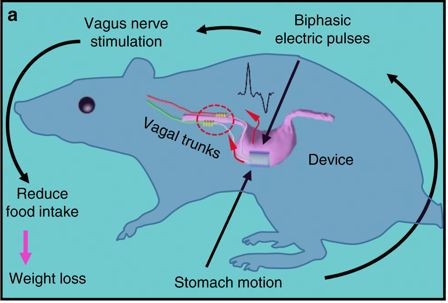Battery-free Implantable Device for Weight Loss
Obesity is considered a rising epidemic affecting more than 700 million adults and children. Measures to control obesity have ranged from risky weight-loss drugs, gastric bypass, to long strenuous diet plans and physical activity.
Learn more about the obesity epidemic:
Now, a study published in Nature Communications proposes a novel measure developed by engineers at the University of Wisconsin-Madison to combat the epidemic—a battery-free, easily implantable weight-loss device.
The implantable device was seen in laboratory testing to shed almost 40 percent of body weight in mice. The device can be implanted through a minimally invasive procedure and is considered safe for use in the body. It is very tiny measuring about a third of the area of a penny.
Specifically, the device works by using the natural churning motions of the stomach to generate gentle electric pulses delivering them to the brain via the vagus nerve. The electrical stimulation tricks the brain into think the stomach is full after only a few bites of food. "The pulses correlate with the stomach's motions, enhancing a natural response to help control food intake," explains Xudong Wang, a UW-Madison professor of materials science and engineering.
Operation principle schematically showing the pathway for electric signal generation by the stomach via the vagus nerve and into the brain.
Credit: Nature Communications
What’s unique about this device is it needs no batteries, electronics, or complicated wiring to function properly—the device relies on the motions of the stomach by the stimulations of the vagus nerve to power its internal generators. "One potential advantage of the new device over existing vagus nerve stimulators is that it does not require external battery charging, which is a significant advantage when you consider the inconvenience that patients experience when having to charge a battery multiple times a week for an hour or so,” says Wang. "It's automatically responsive to our body function, producing stimulation when needed; our body knows best."
Source: College of Engineering, University of Wisconsin-Madison , Nature Communications









